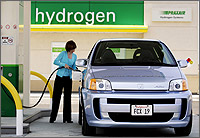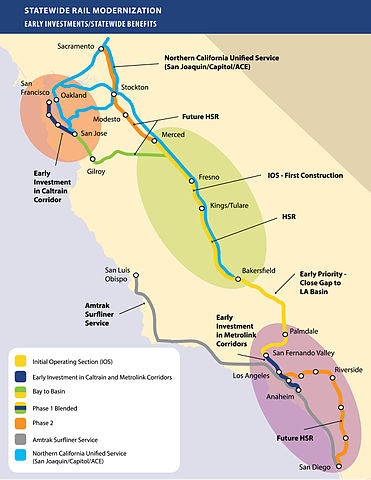It has been reported that if high-speed rail were placed on the California ballot today the electorate would vote it down. While that may be true, it would not be a landslide defeat. There are still a considerable number of Californians that continue to support the project, myself included.
So, keep in mind that California and Texas – land-area-wise – are, in the lower 48, America’s two largest states. I have driven up and down the Golden State and across huge swaths of the Lone Star State – Texas. And, when I say they’re big, trust me: They’re big!
And, I can tell you, driving, it’s not all it’s cracked up to be. Thirty to forty-thousand deaths on America’s highways each year from vehicle crashes. Plus, the amount of time it takes, not counting roadway congestion, behind the wheel, to drive long, I mean, really long distances. These days, who’s got the time?!

I’ve heard arguments both for and against. However, for me and for a significant many, there is no better travel mode. And, when the high-speed element to such in the continental U.S. is at long last attached, that’ll be the icing on the cake.
Why significant numbers continue to resist high-speed rail in America is puzzling. It exists throughout the developed world. And, in those countries where it’s offered, people wholeheartedly embrace it. And, why wouldn’t they?!
Moreover, there are two such systems that have turned a profit – one in Japan; the other in Spain. And, they’re extremely popular; they’re very well patronized, in other words.
Not to mention that they’re fast. While maybe not outperforming flying in that sense, the fastest high-speed train travel is currently three times the speed of the fastest driving. So, in doing the math, travel by high-speed train versus higher-speed car takes one-third the time for traveling distances being equal.


There are those people who look at the expense of high-speed rail-building and cringe. California’s project is estimated to cost $77.3 billion, according to the latest information available. And, Texas’, its program is estimated to be somewhere in the neighborhood of $17 billion. The first is 520 miles long; the second 240. The former has portions that are to be constructed through mountain passes which will require extensive tunneling; the latter, not at all. California’s is to be publicly funded, while Texas’ is to be funded privately.
And on quite a few people’s minds is funding – how this is all going to be paid for.
As it relates, on Sun. Jan. 20th I was watching a local television production known as The Maddy Report. The topic of discussion was state issues of 2018. Political columnist/analyst Dan Walters was one of the two guests and regarding California high-speed rail, in response, Walters seemed adamant, his reply being: “Fish or cut bait.”
Which begs the question: If it were a major multi-lane highway being built instead of the high-speed railway connecting San Francisco and Los Angeles (Phase 1), would he so much as have raised an eyebrow? I wonder. All else being equal, rail is by far the far better bargain, the far better choice in so much as rail is and, for all intents and purposes, has always been steel-based, which is inherently what makes the mode extremely efficient; in fact: rail is the most efficient mode going – period. Why more people don’t understand this is, frankly, hard to get one’s head around.
Not just this, but think what the cost would be to add a new highway or build new airports and new runways, not just in California but in Texas too, to meet the needs of the ever-increasing traveling public.
Meanwhile, the government shutdown, you know, the one that just recently ended, at least for the time being, had a profound negative and possibly compromising effect on domestic aviation as it had to do with ensuring in-flight safety. In the case where passenger rail dispatching is concerned, a government shutdown would in no way have been nearly as impacting. And, inclement weather, while typically sidelining airplanes and automobiles (I mean who hasn’t seen the bevy of reports on the broadcast news documenting the many cancelled flights and scenes of impassable roads), trains, on the other hand, more often than not get to where they’re going. In other words, trains come through at times when other modes don’t.
Light at the end of the tunnel
Travel-mode-wise, what’s been decidedly missing in the United States is high-speed rail.
Choice is always good. None of the other far-off lands that have high-speed rail networks are wrong.
That we’ve gotten with the high-speed rail program, that we’ve finally gotten on board, I say better late than not at all.

Images: Robert Alfers (top); California High-Speed Rail Authority (3rd); Chao-Hwa Chen (bottom)
This post was last revised on Jun. 2, 2020 @ 6:57 a.m. Pacific Daylight Time.
– Alan Kandel
The reason everyone hasn’t accepted it in Texas is because of the estimated average one way cost listed in the DEIS is $199 each way. A family of four couldn’t afford it when you can take the same round trip for 1/4 if the price ($100). You also have the little issue of eminent domain. A private Japanese funded company should not be able to wield the power of eminent domain.